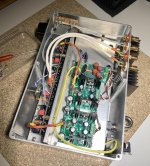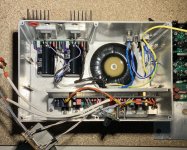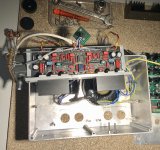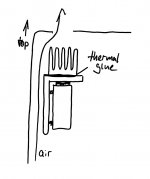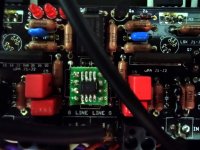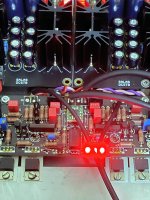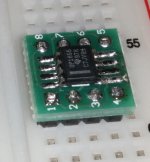Thank you! I’ll take that as a compliment. In fact my job as engineer in the mobile radio certification business puts me at work with the kind of machinery you mean. For my audio projects, this kind of 3D Tetris, with the building blocks I need for the project, that comes from my personal fun challenge to put everything in these Hammond boxes
R-Jik45 blue switch is a gain switch it puts another resistor pair in parallel. Two outputs are isolated by 100 ohm resistor to use for main and sub at same time. Power entry has thermistors and line capacitor. Typical Pass power supply, overkill here, but hey it’s diy and parts are cheap and labor is free
OPA1656 as DC Servo
Hi
I finally tried this new generation CMOS process dual op-amp in the U1 DC servo position. Has both very low voltage noise and low input bias current as well as high current output capability and very low THD. Its SMD only and needs a mini interface board for trying it in the DCG3.
First electrically, it managed the DC offset control task fine to almost zero mV on both channels settling soon enough after power up.
Second subjectively, I think its a good one because coherent. Imparts a sense of calm and purity across the audio band more so than the higher voltage noise BOM standard AD823 which on the other hand seems like lending more power and drama. I listened back and forth between chips both on Sennheiser HD-600 headphones and on my DIY speakers with PHL and Celestion professional audio driver units.
The DC servo position is indirect but influential enough to the finesse of this preamp IMHO and I originally evaluated many candidates to end up with AD823 for a well balanced result.
The OPA1656 shows good potential I believe. Because I never recommend BOM upgrade parts straight away on early impressions in one system, I encourage you guys to try it out and give opinion. Technically this op-amp is high class anyway* and no aspect is at odds with its job description in DCG3. The FFT check was clean at 0.0032% THD+N 1V RMS output with the OPA1656 in place so no anomaly appeared in using it.
But maybe not appealing to everybody's taste and there could also be system synergistic traits at play in my subjective impressions.
Its $2.75 at Mouser's and there are some ready mounted on mini pcb interface for through hole use offers on ebay at about 15 Euro. Empty interface boards are usually described as SOIC8 TO DIP8 Adapter PCB making it cheaper to do it yourself if familiar with surface mount soldering. 2.54mm pitch round pins are needed too. Flat style pins don't fit U1's socket. They are usually sold in a long row as male header pins you can easily cut away in quads or singles. Quads are easy to solder pointing straight.
If anybody else will evaluate it as well, let me know your impressions. If you still prefer the AD823ANZ or you find more merit with the OPA1656 in your own system.
*Features
Ultra-low noise:
Voltage noise: 2.9nV/√Hz at 10kHz
Current noise: 6fA/√Hz at 1kHz
Low distortion:
0.000029% (–131dB) at 1kHz
0.000035% (–129dB) at 20kHz
High open-loop gain: 150dB
High output current: 100mA
Low input bias current: 10pA
Slew rate: 24V/µs
Gain bandwidth product: 53MHz
Rail-to-rail output
Wide supply range:
±2.25V to ±18V or 4.5V to 36V
Quiescent current: 3.9mA per channel
Hi
I finally tried this new generation CMOS process dual op-amp in the U1 DC servo position. Has both very low voltage noise and low input bias current as well as high current output capability and very low THD. Its SMD only and needs a mini interface board for trying it in the DCG3.
First electrically, it managed the DC offset control task fine to almost zero mV on both channels settling soon enough after power up.
Second subjectively, I think its a good one because coherent. Imparts a sense of calm and purity across the audio band more so than the higher voltage noise BOM standard AD823 which on the other hand seems like lending more power and drama. I listened back and forth between chips both on Sennheiser HD-600 headphones and on my DIY speakers with PHL and Celestion professional audio driver units.
The DC servo position is indirect but influential enough to the finesse of this preamp IMHO and I originally evaluated many candidates to end up with AD823 for a well balanced result.
The OPA1656 shows good potential I believe. Because I never recommend BOM upgrade parts straight away on early impressions in one system, I encourage you guys to try it out and give opinion. Technically this op-amp is high class anyway* and no aspect is at odds with its job description in DCG3. The FFT check was clean at 0.0032% THD+N 1V RMS output with the OPA1656 in place so no anomaly appeared in using it.
But maybe not appealing to everybody's taste and there could also be system synergistic traits at play in my subjective impressions.
Its $2.75 at Mouser's and there are some ready mounted on mini pcb interface for through hole use offers on ebay at about 15 Euro. Empty interface boards are usually described as SOIC8 TO DIP8 Adapter PCB making it cheaper to do it yourself if familiar with surface mount soldering. 2.54mm pitch round pins are needed too. Flat style pins don't fit U1's socket. They are usually sold in a long row as male header pins you can easily cut away in quads or singles. Quads are easy to solder pointing straight.
If anybody else will evaluate it as well, let me know your impressions. If you still prefer the AD823ANZ or you find more merit with the OPA1656 in your own system.
*Features
Ultra-low noise:
Voltage noise: 2.9nV/√Hz at 10kHz
Current noise: 6fA/√Hz at 1kHz
Low distortion:
0.000029% (–131dB) at 1kHz
0.000035% (–129dB) at 20kHz
High open-loop gain: 150dB
High output current: 100mA
Low input bias current: 10pA
Slew rate: 24V/µs
Gain bandwidth product: 53MHz
Rail-to-rail output
Wide supply range:
±2.25V to ±18V or 4.5V to 36V
Quiescent current: 3.9mA per channel
Attachments
They were there right from the start so I can't tell you if any better than with C0G. Its the prototype. You can also see them in post #1 and in the build guide's photos. Having listened to other builds with standard TDK C0G C1 C2, I don't think they sounded unfamiliar though.
For upgrades I only concentrated in the known discussed active parts alternatives and volume pots.
For upgrades I only concentrated in the known discussed active parts alternatives and volume pots.
Product code or link?
Mouser No: 200-TS114GAA is the style of pins that worked (0.46/0.018 DIA)

NE5532 pin dimensions. Suggesting we can use 0.46mm or 0.018 inch pins of any shape
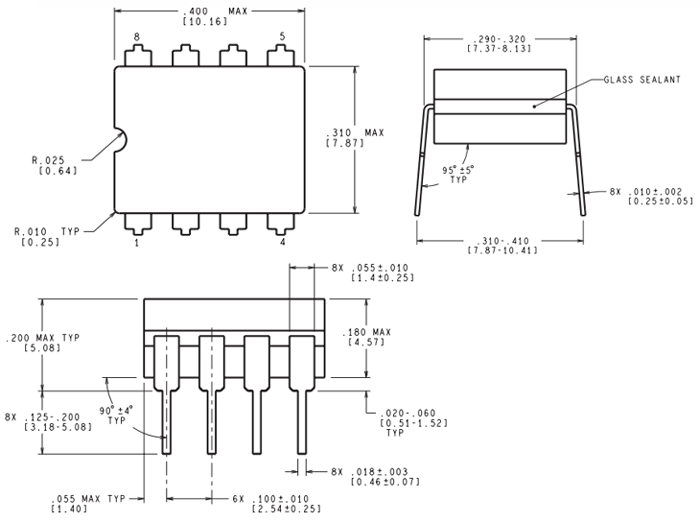
Square pins on adapters are usually 0.64/0.025 for breadboard prototyping not for tight DIP-8 sockets
Check out Sparkfun BOB-13655 pin-less and Aries 08-350000-10 pin-ready adapter boards
Mouser No: 200-TS114GAA is the style of pins that worked (0.46/0.018 DIA)

NE5532 pin dimensions. Suggesting we can use 0.46mm or 0.018 inch pins of any shape

Square pins on adapters are usually 0.64/0.025 for breadboard prototyping not for tight DIP-8 sockets
Check out Sparkfun BOB-13655 pin-less and Aries 08-350000-10 pin-ready adapter boards
I‘m not sure I understand how an OpAmp in DC servo duty, which to my knowledge adds a DC voltage that only slowly changes over time, can alter sonic characteristics that lead to a different listening impression like stated earlier. Can someone enlighten me on how that works theoretically?
- Home
- Source & Line
- Analog Line Level
- Salas DCG3 preamp (line & headphone)
